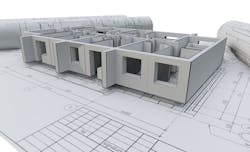3D Printed Homes Won’t Be Enough to Solve a Nationwide Inventory Shortage
While the rise of readily available 3D printing technology sounds like a promising solution for a housing industry battling supply shortages from coast to coast, it may not be so helpful when put into action, says The Washington Post. Large-scale 3D printers can greatly reduce construction times, but they only account for a small portion of the work required to complete a residential project. The structural frame is the bread and butter of a 3D home printing project, but most construction costs come from materials and services required beyond just a home’s foundation.
Not only does 3D printing save only a meager share of construction costs, but the up-and-coming building technology isn't feasible for all residential projects and likely won't provide a quick fix to a decade-old housing shortage.
The prospect of 3D printing of a house, ingenious as it sounds, is yet another in the long list of technological home-building ideas whose time has not come and probably never will come. It’s also an idea that carpenters and masons may not appreciate.
Home builders, practicing architects and engineers know that labor and materials for the structural frame — walls, floors, roof — of a house represent a small fraction of the total cost of a completed home ready for occupancy. Even if framing costs were cut in half, total building costs and selling price would be affected by an insignificant percentage, if at all.
